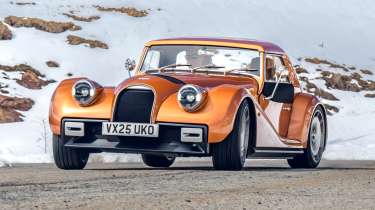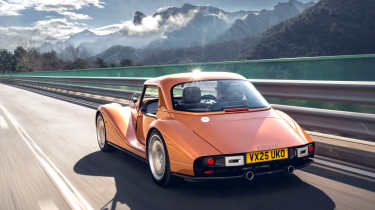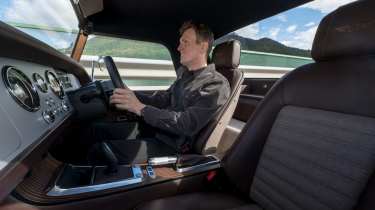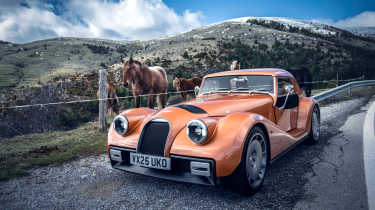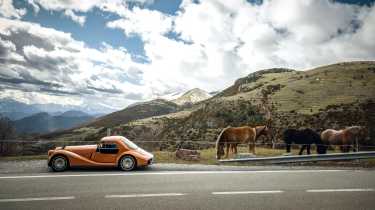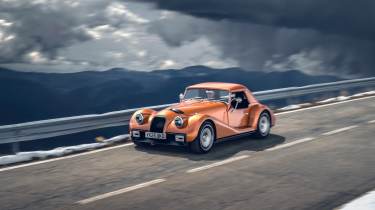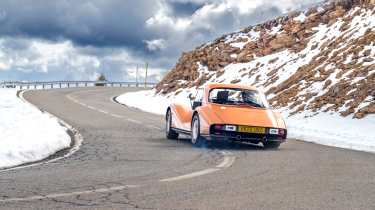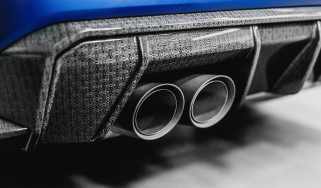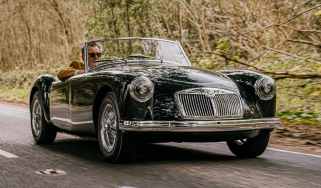Morgan Supersport 2025 review – Malvern's alternative to a Porsche Cayman GTS
Morgan’s new flagship is its most versatile car yet. Does modernising mean losing the magic?
Roof on, sidescreens off. The mountain air spilling into the cabin is bitingly cold but the air flowing through the vents in the dash is toasty and the heated seats are on. The tarmac is dry but blankets of fresh snow border the road. A storm is brewing on the horizon, coal-black clouds rolling in, but the sunlight reflected from the snow is so bright I’m squinting even through my sunglasses.
It’s a setting of contrasts and a car of contrasts too. We’re a couple of hours north of Barcelona in the Morgan Supersport. It’s a new flagship for the 116-year-old company, indirectly replacing the Plus Six, which ended production in March. In positioning, it sits somewhere between the Plus Six and the previous Aero 8, facing off everything from the Porsche Cayman and Boxster GTS 4.0 and even the 911, to the Lotus Emira. In style, it’s one of the most forward-facing Morgans yet. Whereas the Plus Six could have driven out of almost any decade in the second half of the 20th century, the Supersport’s treatment is much more of-the-moment. Nevertheless, it’s instantly recognisable as a sports car from Malvern; it could only be a Morgan.
More reviews
Group tests
- Alpine A290 v Alpine A110 – how much DNA do they really share?
- Ariel Atom 4R v Caterham Seven ‘evo25’: power-to-weight heroes go head-to-head
- Bentley Continental GT Speed v Aston Martin DB12 v Maserati GranTurismo – which is the ultimate grand tourer?
- Caterham Super Seven 600 v Super Seven 2000
- Levante v T1
- Corvette Stingray v Porsche Cayman GTS v Audi R8 RWD
- Volkswagen Golf GTI Clubsport v Cupra Leon 300 – what's the best mainstream hot hatch?
- Great Ferrari hypercars driven: 288 GTO, F40, F50 and Enzo head-to-head
- GMA T.50 v McLaren F1 – has the best car in the world been dethroned by its successor?
- Lamborghini Aventador Ultimae v Lamborghini Countach
In-depth reviews
- Abarth 600e 2025 review – Italy gives the Alpine A290 something to worry about
- Alpine A110 2025 review – one of the all-time sports car greats will soon be gone
- Audi R8 (2015 - 2024) review – the ultimate soft-focus supercar
- BMW iX 2025 review – the ugly duckling still stomps the Tesla Model X
- BMW 5-series review – is this still Munich’s anchor model?
Long term tests
- Abarth 695C Turismo Fast Fleet test – 10,000 miles in the Italian hot hatch
- Alfa Romeo Giulia Veloce Fast Fleet test – 7000 miles in the sharp Italian saloon
- Alpina B10: end of term report
- Alpina B10
- Caterham Seven evo25 Fast Fleet test – living with a track car for the road
- Caterham Seven evo Edition revealed – bespoke 420R joins the Fast Fleet
- Cupra Leon Estate 310 4Drive Fast Fleet test – living with the 306bhp hot estate
- Ford Mustang GT
- Ford Mustang GT
- Land Rover Defender 110 Fast Fleet test – 9000 miles in the go-anywhere SUV
Review
- New Aston Martin DBS 770 Ultimate review – 759bhp super-GT driven
- New Bentley Batur 2023 review – can it possibly be worth £1.65m?
- 2023 Chevrolet Corvette C8 Z06 review – the American 911 GT3?
- Kia EV6 GT-Line S prototype review – the EV that shows how it’s done
- BBR Supercharged Mazda MX-5 (ND) 2023 review – tuned 250bhp roadster driven
- MG4 Trophy 2023 review
Reviews
- Abarth 695 75 Anniversario edition 2024 review – a fitting send-off for Abarth’s hot supermini?
- Abarth 500e 2023 review
- AC Cobra 378 Superblower MkIV 2021 review – another V8 Cobra, but with a GM heart this time
- Acura Integra Type S 2024 review – a Honda Civic Type R with added restraint
- Alfa Romeo 33 Stradale 2025 review – a rare Italian jewel beyond compare
- Alfa Romeo Giulia 2025 review – get one while you still can
- Alfa Romeo SZ: history, review and specs of an icon
One of the most useable Mogs yet, too, with wireless phone-charging, Bluetooth for hands-free calls and, more prosaically, it’s the first Morgan in more than ten years with a boot (just big enough to store the side-screens in, so no need to leave them at home or stash them in a friend’s car this time). With considerable detail refinements to steering and suspension, it also promises to be a more modern Morgan in the way it drives. It’s a not inconsiderable amount of money, at £102,000 on the road in the UK before options, although that’s not uncharted territory, as various Aero 8 models topped the six-figure barrier in the past.
Like the Plus Six, the Supersport is powered by BMW’s B58 3-litre turbocharged straight-six and built around a bonded aluminium structure with double-wishbone suspension. It’s an evolution of the CX platform launched in 2019, used for both the Plus Six and the four-cylinder Plus Four, which continues in production. The CX (named for the Morgan Motor Company’s 110th year in Roman numerals) represented a big step forward for Morgan-kind; this new evolution is named CXV (since it was designed in Morgan’s 115th year, and besides, CXVI would be a bit of a mouthful). It’s both lighter and stiffer than the CX chassis and features redesigned suspension and steering. So comprehensive have the alterations been that it’s required a fresh round of crash tests for homologation – a considerable investment for Morgan and its owners, the private equity group Investindustrial.
The platform still incorporates an ash wood frame beneath the hand-formed aluminium body panels (in fact, there’s a greater amount of ash than previously), and Morgan’s designers have made part of it visible for the first time – pop the boot and there’s a boattail-style wooden lip to the load area. It’s a nice touch, among many.
Around 200 Supersports will be built per year, and it’s homologated for Morgan’s various markets around the world (including the UK, Europe, the Middle East, Japan and Indonesia) with the exception – for now – of the US.
That Morgan has chosen to conduct a specific, Spanish-based media launch for the Supersport underlines its significance. It’s far more relaxed than a typical car launch, however. No PowerPoint presentation, no pretentious and protracted multi-course dinner, no branded takeover of a venue. Photographer Andy Morgan and I have the car to ourselves for the day, for as long as we need. No route to follow, no mandated coffee stop venue, no curfew to be back in time for. If Carlsberg did car launches, etc.
We strike out for the mountains, acclimatising to the car and its cockpit. The sense of occasion is lovely: the circular shaving-mirror-style wing mirrors, the chrome lozenge of the main rear-view mirror, and the flowing fenders ahead. The sense of quality impresses, too: fit and finish is excellent, and the two-tone leather, walnut and aluminium veneer, and box-weave carpet all add to the ambience (though all are optional, among a cool £24,211 of extras fitted to this test car – more on which later).
The steering wheel spokes have a nicer finish than those of the Plus Six, and it looks less like a nondescript catalogue item with a Morgan badge. The whole interior now looks suitably bespoke, apart from the gear selector lever, instantly recognisable from older-generation BMW models. Why doesn’t Morgan just design its own casing? Because, as with all automotive switchgear, there’s a snakepit of costs in creating bespoke items (especially a gear selector, with its mandated safety protocols requiring iterative designs and multiple approvals). It would have added a scary amount to the budget, so the money’s been spent elsewhere.
That’s immediately apparent as we join the autovía and settle in to a cruise. One of the first things that strikes you is how composed the ride is. In Pluses Four and Six, expansion joints on dual carriageways thud through the car noticeably, but the Supersport absorbs them smoothly. The body is well controlled vertically over undulations too. This car is fitted with the Dynamic Handling Pack, a £3000 option that adds 24-stage, single-way-adjustable Nitron dampers (standard cars ride on non-adjustable Spax dampers). Front and rear anti-roll bars are standard; the front is a new, stiffer design than that of the Plus Six, which didn’t have a rear anti-roll bar.
The redesigned steering system is faster than before, and much more linear, with one of the universal joints removed to reduce friction. It feels very… mature, like that of a high-volume production car rather than a small, independent outfit. It’s not as brimming with talkative feedback as you might expect of a lightweight sports car (the Supersport weighs just 1170kg) but in fact its calm, measured accuracy and insulation from bumps and cambers are great attributes. Together with the smooth high-speed ride comfort, they lend the car a grand tourer character; it’s an easy-going companion for a long-distance road trip. Not an attribute you might applied to all Morgans in the past.
A bit of wind noise always finds its way around the edge of the sliding plastic sidescreens, no matter how determinedly you slide them to their stop. I struggle a bit for elbow space with the screens in place, and my road-side arm’s a bit more comfortable with them removed and stowed in the boot. A neat design makes that easier than ever: slide the little chrome door lever a further click past its usual stop and the screen’s released, sliding smoothly out of the door. With the screens in the boot, Andy needs to share the passenger side of the cabin with his camera bag, but there’s a good amount of space behind the seats to stash road-trip essentials.
The pleated seats look lovely, although I crave a little more adjustment. The base isn’t height-adjustable and is a little high for my tastes, though the hip-point is set by homologation requirements. The steering is both reach- and rake-adjustable, which is great, although the constraints of the low dash place it a little lower than I’d like. The seatback adjusts via an elegant chrome lever, but it’s a little all-or-nothing in operation, making it tricky to tweak while driving.
As the road gets twistier, I find I need a little more side support too (though there’s much more than in the original Plus Six) and brace my body with my left leg against the footrest. There’s plenty of space in the footwell, because there’s no clutch pedal, the Supersport being offered as an automatic only. Customers only have themselves to blame: the vast majority of Plus Four buyers choose the auto option, so it wouldn’t be cost-effective for Morgan to develop and manufacture a manual option for what it estimates would be a small percentage of sales.
The transmission is an eight-speed by ZF, and you can use manual shift paddles behind the steering wheel if you wish (or push-pull the lever). There are three driving modes: it defaults to its regular setting on start-up, the perkier Sport mode is selected by sliding the lever across to the left, and Sport Plus – which further sharpens the throttle and gearchange maps – is toggled via a button on the transmission tunnel. This car has the £3000 Active Sports Exhaust option, which becomes louder in Sport and Sport Plus. Engine noise is well insulated with the roof in place; it could actually afford to be more vocal.
The auto-mode gearchange logic, refined by Morgan, is well calibrated and makes the right decisions at the right time, holding lower gears on the way down a steep incline, for example. There are plenty of those here. Winding our way further into the mountains, we encounter little villages perched on mountainsides with ever narrower streets, some cobbled, all steep.
The Supersport gets plenty of attention, all of it overwhelmingly positive, and locals frequently approach to ask polite questions about the car. They don’t speak English, I only know a few words of Spanish and can’t speak any Catalan, but conversations go on for a long time in a mixture of sign language and Spanglish. And that happens whenever and wherever we stop, however remote.
The Supersport’s design is based partly upon that of the Midsummer, a 50-off Plus Six barchetta that was styled in collaboration with Pininfarina and revealed last year. Finished in Copper Metallic (an ’80s Porsche colour, incidentally; as with other Morgans, colour choice is claimed to be ‘almost limitless’), this is a striking and exciting car to walk around, with some lovely details to drink in. While it retains the traditional Morgan silhouette, its shoulder line has evolved with higher doors and a lifted tail.
Controversially in some quarters, it replaces the traditional ‘waterfall’ vertical strakes on the grille for a textured finish (in satin chrome as standard, or dark finish as an option), and the louvres along the bonnet for an air extractor band behind the badge. The LED headlights incorporate the indicators, without separate satellite pods as per traditional Morgans. For buyers who still want a totally trad Morgan, the Plus Four continues in production unchanged and as deliciously retro as ever.
The Supersport is a particularly dramatic-looking car with the optional carbon-composite hard-top and Aerolite wheels fitted, as here. As standard the car comes with a black mohair soft-top included in the basic £102,000 list price. If you choose instead to have the hard-top you pay an extra £4194, or if you want both, that costs an extra £6594. The hard-top’s expansive curved glass lets a great deal of light into the cabin and gives genuinely superb all-round visibility at junctions, too. And even with all that glass, the roof weighs less than 20kg. Those 19-inch disc wheels, which weigh 9.7kg a corner, are a £4800 option. The standard 18-inch Superlite wheels are 10.8kg per corner.
The 19s wear very modern Michelin Pilot Sport 5 tyres, measuring 235/40 at the front and 255/40 at the rear. They give the Supersport plenty of grip on these smooth, dry roads. It’s a very calm car – that’s the word. As well as avoiding getting unsettled over bumps, its handling balance is predictable. This car’s dampers are in their baseline setting for UK roads – at 15 clicks out of 24, with 1 being the firmest and 24 the softest – and there is a reasonable amount of body roll. It’s worth caveating that these Spanish roads are very smooth, and so in the UK the softness may be less accentuated. Dive and squat are well contained, and when we do hit some bigger compressions and bumps at speed, there’s no sign of the suspension running out of travel.
Brake feel and response are excellent, too. On repeated runs back and forth for Andy’s camera on this winding mountain road, the brakes do begin to smell a little hot, but that may be because I initially have the stability control (the car features both ESC and ABS) set to its halfway-off Sport mode. Switched off fully, the Supersport remains a predictable, safe handler. In fact, it feels like the chassis could handle more than the current 335bhp and 369lb ft. Which isn’t something you might necessarily have said about the old Plus Six, which could be a touch lairy at times.
It’s tidier too than the Handling Pack-equipped Plus Four we sampled on 2024’s evo Car of the Year test. The Supersport’s chassis, which weighs 102kg including the front and rear subframes, is ten per cent stiffer than the Plus Four’s (and a further eight per cent or so with the hard-top in place), and some of the suspension mounting points are as much as 100 per cent more rigid than before. It shows.
If there’s a criticism, it’s that its pliant, predictable balance feels almost more like a saloon car’s than a sports car’s; it feels like there’s headroom to make the Supersport sportier still – but there’s plenty of scope for customers to adjust the dampers, and this particular car doesn’t have the optional limited-slip diff, which would tighten its handling further.
An option it does have is the Sennheiser audio system (£3600) with a Bluetooth link to listen to music or make hands-free calls (an extra £330). It’s incongruous to see a smartphone slot integrated into a Morgan transmission tunnel, and in some ways it’s representative of the car as a whole. The Supersport is a car with a far wider bandwidth than a typical low-volume sports car. Its aesthetics move the Morgan template forward without diluting its appeal, it possesses more day-to-day usability than ever, and its dynamics are impressive. It’s a car that could appeal not only to die-hard Morgan fans but to a wider group of customers who might not previously have considered a car from Malvern. It deserves their attention.
Price and rivals
Modernised though it is, the Morgan Supersport is still at the esoteric end of the sports car space. The obvious comparisons from Porsche and with the Cayman and Boxster GTS 4.0 and 911 Carrera, the former cheaper (<£80k) than the Morgan and the latter about equal once you factor in options. All are more polished in almost every area, though you do get something different, something very special, with the little Morgan that could. Further in the quirkier, more alternative direction is the Lotus Emira, which, while less polished than the Porsche's, could offer something slightly more rounded than the most usable Morgan to date.
2025 Morgan Supersport specs
| Engine | In-line 6-cyl turbocharged, 2998cc |
|---|---|
| Power | 335bhp @ 6500rpm |
| Torque | 369lb ft @ 1600-4500rpm |
| Weight | 1170kg (286bhp/ton) |
| Tyres | Michelin Pilot Sport 5 |
| 0-62mph | 3.9sec (pending final certification) |
| Top Speed | 166mph (pending final certification) |
| Basic Price | £102,000 |
